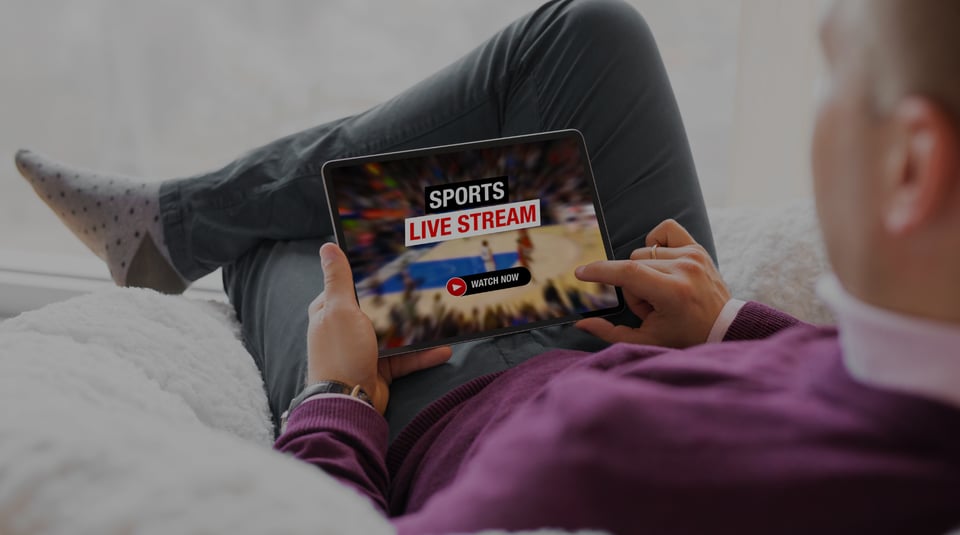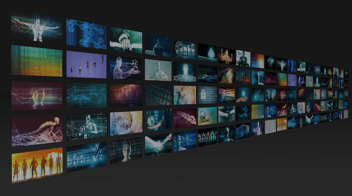
George M. Perry
Over-the-top (OTT) streaming services flipped the supply and demand curve between sports leagues and broadcast media. By developing their own OTT platform, leagues of any size can have a wider range of engagement and revenue opportunities than TV broadcasts could ever deliver.
The first 90 years of broadcast sports were defined by scarcity. There was only so much spectrum – first for radio, then for television – to go around, and the broadcast range meant the content could only go so far.
Cable television expanded the number of channels using a technology better suited for large-scale distribution. But there was still a limited number of channels and high barriers to entry; and viewers, particularly for live events like sports, were constrained by the broadcasters’ schedules. You either watched a game when it was on, or you didn’t. If you wanted to watch two games that fell at the same time, you had to choose.
Sports leagues benefitted from a windfall as fans’ demand for sports grew far faster than cable companies could add and market TV channels. Throughout the 2010s, TV networks intensified their bidding wars every time a professional league or collegiate conference had their rights up for renewal. By the end of the decade, Major League Baseball increased their deals with TBS and Fox by 34% and 46%, respectively, for a combined $1.2 billion; NCAA March Madness by 43% to $1.1 billion; and the SEC by 61% to $330 million. Even the smaller mid-major conferences took a piece of the action. Helping satisfy ESPN’s need for sports content, the Sun Belt Conference raised their game by 250% for an $8 million deal, while the American Athletic Conference increased their rights fees 363% to $83 million.
But the smaller college conferences plug into the massive college sports industry; and these broadcast deals were centered around the two “revenue-generating” sports of football and basketball.
Broadcasters met the increasing demand by giving fans much more of the same – the same big sports from the same big leagues – rather than expanding the breadth of their programming. This was completely logical and defensible: with a limited number of platforms available, broadcasters and rights holders needed a concentrated strategy to maximize value.
Niche leagues and minor leagues were left with the same options they always had: look for coverage opportunities on local channels or buy airtime – typically the least desirable days and hours – on regional or national sports networks.
Over-the-top streaming platforms ended this dynamic, inducing market corrections that have the major incumbents pivoting quickly while minor and niche sports explore new worlds.
Benefits of having a own streaming service for sports leagues
- Over-the-top platforms don’t level the playing field – they create a new one
- Content expansion through over-the-top platforms
Over-the-top platforms don’t level the playing field – they create a new one
Unlike the channels on traditional TV, there is no upper limit on the number of streaming apps an OTT platform can offer. There are no issues of carriage fees, as with cable TV; no technological constraints like spectrum; nor any business case for an OTT service to reject a team’s or league’s streaming solution. Hosting each additional app is a marginal cost for the OTT platform.
The supply of OTT opportunities is essentially unlimited. Any sports league or team can create their own OTT streaming app and reach their fans through platforms such as Roku, SlingTV or Twitch on their smartphones, tablets or smart TVs. They can reduce the middlemen even more by going direct to consumer through a league or team app available at the Apple Store or Google Play.
Along with access, OTT platforms give minor leagues and niche sports something else they’ve never had: control.
Sports properties can offer a blend of live and on-demand programming: games and studio shows can be shown live and available on-demand afterwards, while classic games, highlights, analysis shows can be on-demand from the moment of release.
The league and the fan work together to determine what the fan can watch and when. This is a departure from the broadcast route, where the property may only have two hours once a week and, therefore, has to deliver its top content in that time slot. And it is a collaborative engagement between the property and the viewers. Like any digital product, viewer data flows back to the owner in real-time. Instead of macro-level Nielsen data that arrives a week after an event is broadcast, OTT apps enable the property to understand fan patterns and preferences from the total audience level to the individual viewer level.
This data influences the financial model as well as the content schedule.
If a broadcaster does not buy a league’s media rights, the only way the league can be on TV is by buying a block of airtime. The league has to figure out how they will make money from advertisements during that time.
Do they buy a longer block of time with the expectation that they can sell and insert commercials during breaks in play, like in football or baseball? Or do they buy a shorter block of time and hope to generate revenue via on-screen advertisements, like in soccer? These decisions carry a lot of risk for the league, with slim prospects for more than a marginal profit. The necessary analysis would often require data and insights that properties at this level do not have in-house: they either need to hire an outside consultant, further raising their costs, or take a gamble on incomplete information.
Sports leagues can use their OTT streaming app to make money any way they want to (well, any way the market will bear).
The app can be for subscribers only; can offer a mix of free and premium content for subscribers; pay-per-view, especially for live events; or be fully free for the consumer.
Leagues may use their streaming app as a loss leader for their other sales and marketing efforts, such as ticket and merchandise sales, esports activations or, increasingly, sports betting tie-ins. Data-driven studio shows, analysis or in-game overlays are particularly well-suited for the burgeoning sports betting industry in the US.
Leagues could also build the app into their sponsorship packages and generate revenue via their sponsors. That is a very attractive possibility for the sponsors, who would not only welcome the access to and data from the fans, but the opportunity to be seen as the “good guy” by providing fans with something we all know they want: free content!
Over-the-top streaming services meet the broad demand for more sports programming and, within each segment of that market, give sports leagues a way to meet whatever other demands the fans have and are willing to pay for.
Content expansion through over-the-top platforms
As media rights prices hit new records on an annual basis throughout the 2010s, people began asking the same question they always ask in such situations: are the prices rising or inflating? OTT streaming services emerged as the externality that would either reverse the rise or pop the bubble.
The largest sports leagues, who had grown rich but dependent on the media rights market, worried about both possibilities. Streaming threatened to replace their major revenue stream. Yet they knew they could not ignore it. Over-the-top platforms had to become at least an adjunct product offering while they looked for ways to minimize the potential drop in revenue upon their next broadcast rights renewal. Striking the balance between what had to be broadcast live and what could be available on-demand allowed major leagues to develop an integrated media and content suite.
For minor leagues and niche sports, OTT streaming has been purely additive, but it should be no less complementary to all the other ways they “meet the fan where they are.”
Content developed for an on-demand library can be edited for consumption across all social media channels. The social media channels can feed back into the OTT app through user-generated content. A fan may capture a better angle of a highlight than any of the few cameras a minor league team has at their stadium. Fan-hosted shows from Instagram Live (vetted for appropriateness, of course) could be a way to deepen engagement with online fan communities while also padding the content library. And a curated collection of fans’ social media posts could be a good way to get an extra few minutes of key demographic eyeballs on the app when not much else is going on around the league.
Entering the OTT stream with ViewLift
Over-the-top streaming platforms put fans within reach of smaller sports properties like never before. ViewLift puts those platforms within reach of the leagues looking to take that next step. Contact us today to start making your way to the OTTs, smartphones, tablets and smart TV’s of the fans waiting to hear from you.
SHARE THIS POST
What to read next
Host & Stream Your Sports Broadcast with ViewLift’s OTT Platform In 2023
Sports broadcast is not new to content publishers. Still, with the popularity of OTT streaming...
Free Ad Supported TV (FAST) – A Comprehensive Guide to Free Streaming Services
Free Ad Supported TV (FAST): FAST channels are becoming a promising revenue model for broadcasters...
Live Sport Streaming: 10 Tips to Online Broadcasting Success
Welcome to the captivating world of live sport streaming and online broadcasting, where fans can...


